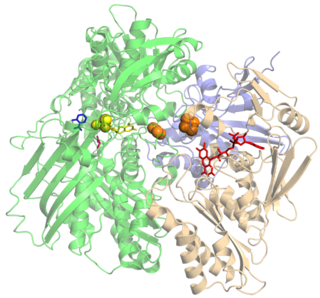
Xanthine oxidase is a form of xanthine oxidoreductase, a type of enzyme that generates reactive oxygen species. These enzymes catalyze the oxidation of hypoxanthine to xanthine and can further catalyze the oxidation of xanthine to uric acid. These enzymes play an important role in the catabolism of purines in some species, including humans.

Retinal is a polyene chromophore. Retinal, bound to proteins called opsins, is the chemical basis of visual phototransduction, the light-detection stage of visual perception (vision).

Aldehyde oxidase (AO) is a metabolizing enzyme, located in the cytosolic compartment of tissues in many organisms. AO catalyzes the oxidation of aldehydes into carboxylic acid, and in addition, catalyzes the hydroxylation of some heterocycles. It can also catalyze the oxidation of both cytochrome P450 (CYP450) and monoamine oxidase (MAO) intermediate products. AO plays an important role in the metabolism of several drugs.

Pyridoxine 5′-phosphate oxidase is an enzyme, encoded by the PNPO gene, that catalyzes several reactions in the vitamin B6 metabolism pathway. Pyridoxine 5′-phosphate oxidase catalyzes the final, rate-limiting step in vitamin B6 metabolism, the biosynthesis of pyridoxal 5′-phosphate, the biologically active form of vitamin B6 which acts as an essential cofactor. Pyridoxine 5′-phosphate oxidase is a member of the enzyme class oxidases, or more specifically, oxidoreductases. These enzymes catalyze a simultaneous oxidation-reduction reaction. The substrate oxidase enzymes is hydroxlyated by one oxygen atom of molecular oxygen. Concurrently, the other oxygen atom is reduced to water. Even though molecular oxygen is the electron acceptor in these enzymes' reactions, they are unique because oxygen does not appear in the oxidized product.
In enzymology, an acyl-CoA oxidase (EC 1.3.3.6) is an enzyme that catalyzes the chemical reaction
In enzymology, a cholestanetriol 26-monooxygenase (EC 1.14.13.15) is an enzyme that catalyzes the chemical reaction
Long-chain alcohol oxidase is one of two enzyme classes that oxidize long-chain or fatty alcohols to aldehydes. It has been found in certain Candida yeast, where it participates in omega oxidation of fatty acids to produce acyl-CoA for energy or industrial use, as well as in other fungi, plants, and bacteria.
In enzymology, a thiamine oxidase (EC 1.1.3.23) is an enzyme that catalyzes the chemical reaction
In enzymology, an abscisic-aldehyde oxidase (EC 1.2.3.14) is an enzyme that catalyzes the chemical reaction
In enzymology, an aryl-aldehyde oxidase (EC 1.2.3.9) is an enzyme that catalyzes the chemical reaction
In enzymology, a glyoxylate oxidase (EC 1.2.3.5) is an enzyme that catalyzes the chemical reaction
In enzymology, an indole-3-acetaldehyde oxidase (EC 1.2.3.7) is an enzyme that catalyzes the chemical reaction

In enzymology, an oxalate oxidase (EC 1.2.3.4) is an oxalate degrading enzyme that catalyzes the chemical reaction:

In enzymology, a retinal dehydrogenase, also known as retinaldehyde dehydrogenase (RALDH), catalyzes the chemical reaction converting retinal to retinoic acid. This enzyme belongs to the family of oxidoreductases, specifically the class acting on aldehyde or oxo- donor groups with NAD+ or NADP+ as acceptor groups, the systematic name being retinal:NAD+ oxidoreductase. This enzyme participates in retinol metabolism. The general scheme for the reaction catalyzed by this enzyme is:
In enzymology, a 3-hydroxyanthranilate oxidase (EC 1.10.3.5) (also called 3-HAO) is an enzyme that catalyzes the chemical reaction:
In enzymology, a D-aspartate oxidase (EC 1.4.3.1) is an enzyme that catalyzes the chemical reaction
In enzymology, a D-glutamate oxidase (EC 1.4.3.7) is an enzyme that catalyzes the chemical reaction
In enzymology, a L-glutamate oxidase (EC 1.4.3.11) is an enzyme that catalyzes the chemical reaction
In enzymology, a nitroalkane oxidase (EC 1.7.3.1) is an enzyme that catalyzes the chemical reaction
In enzymology, a N-methyl-L-amino-acid oxidase (EC 1.5.3.2) is an enzyme that catalyzes the chemical reaction






